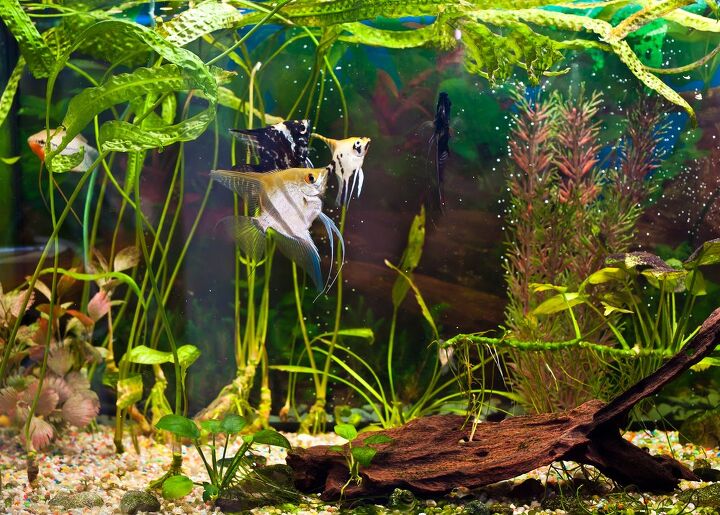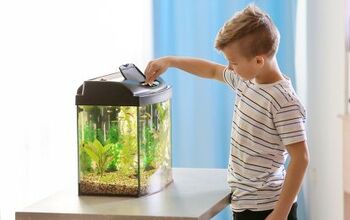How To Increase Oxygen In Your Fish Tank

Fish tanks are vulnerable to everything from disease, infection, pH imbalances, and dirty water. Each of these threats is real, but oxygen can pose just as much of a threat to your fish if the level is off balance. Understandably, you may want to know how to increase oxygen in your fish tank.
The best way to increase oxygen in your fish tank is to pour the water from high up and install an air pump. Agitate the water’s surface as much as possible to oxygenate your fish tank and change the water 1-2 times per month. Add lights to your tank if you have plants. Otherwise, the tank will have more carbon dioxide than oxygen, and your fish may die.
Watch your fish each day and pay attention to their breathing and swimming habits. You can tell that your tank doesn’t have enough oxygen if they frequently rush to the surface and gasp for air. Follow along as we explore how to increase oxygen in your fish tank.
How Do I Know If My Fish Tank Has Enough Oxygen
You can tell your tank doesn’t have enough oxygen if the fish slow down, stop eating, and rush to the surface. Fish will enter crisis mode when there isn’t enough available oxygen in the water. You will likely notice them crowd near the surface of the tank to try to get as much oxygen as possible.
A lack of oxygen can also affect their appetites and swimming patterns. Pay attention to their gills if you suspect your fish don’t have enough oxygen. The gills will rapidly flutter if there isn’t enough oxygen in your tank.
The worst-case scenario is that your fish will die because of the lack of oxygen. Of course, this is quite sad, but you can use the experience to avoid it going forward. Invest in an oxygen monitor and watch your fish closely to examine their behaviors and make sure they get enough oxygen.
How To Get More Oxygen In Your Fish Tank
Whether it be changing the water or agitating the surface, you can increase the oxygen in your fish tank with several methods. Oxygen is just as important to your fish tank as the water and fish themselves. Let’s look at the best ways to oxygenate your aquarium so your fish stay happy and healthy.
1. Change The Water
The quality and amount of water in your tank are arguably the most important things to consider when it comes to oxygen. How much water is in your tank and how clean it is ultimately affects how much available oxygen there is. It’s important to change the water in your tank every 2-4 weeks to keep it clean and oxygenated.
The nitrate level in your fish tank will increase if you don’t change the water frequently enough. This can also cause algae blooms to grow, and that eventually depletes the oxygen in the tank. Clean water will help the fish function as well as possible, increase their appetites, and prevent infections.
2. Install An Air Pump
The easiest way to get more oxygen in your fish tank is to simply install an air pump. Air pumps increase circulation throughout your fish tank, and they also help maintain healthy water levels. The influx of oxygen is exactly what your fish need if they’ve been rushing to the surface to breathe.
Air pumps introduce oxygen to the tank and agitate the surface, which further increases oxygen. That said, not all fish species respond well to air pumps in a fish tank. For example, betta fish don’t always like an air pump, so you may want to avoid it altogether.
3. Agitate The Surface
If your fish tank is low in oxygen, it’s likely because the water is stagnant. Stagnant water lacks oxygen, and your fish will eventually suffer from it. Luckily, it’s easy to agitate the water’s surface to increase oxygen in your aquarium.
As previously mentioned, an air pump works to agitate the surface and oxygenate your aquarium. You can also install a power filter that hangs in the back of your tank to agitate the water’s surface. Set the filter to blow upward to add as much oxygen to your tank as possible.
Air stones can also help agitate the surface, and they aren’t as loud as some power filters. They can also stimulate your fish because they increase water resistance. This will increase oxygen, strengthen your fish, and reduce nitrate levels.
4. Pour Water From Higher
You can significantly raise the oxygen level in your fish tank if you pour the water from up high. This will agitate the surface of the tank, and that can infuse the tank with oxygen.
That said, you must be careful to make sure you don’t agitate the substrate at the bottom of your tank. You can easily disturb the substrate at the bottom of the tank if you pour the water from too high. The force of the water is enough to stir the substrate and make your water dirty.
5. Adjust The Water Temperature
Even the temperature of the water in your fish tank can affect the oxygen level. Ideally, you shouldn’t put water in your tank that is warmer than 70 degrees Fahrenheit when you change the water. Warm water doesn’t retain oxygen as well as cold water.
This can be difficult to balance, as some fish species require warmer water than others. In that case, you must take other measures to increase oxygen in your fish tank.
6. Add Lights
How many lights you have in your fish tank can also affect the oxygen level. For example, a lack of light can deplete oxygen in your tank if you have plants. There will be an imbalance of carbon dioxide and oxygen if you have plants and fish in your tank without any lights.
The lack of light will also cause your plants to stop growing and eventually die. Ideally, you should keep the lights in your tank on for up to 12 hours a day. This will ensure that your plants produce more oxygen than carbon dioxide. It will also make your tank look much better, as the plants will thrive.
Can Your Fish Tank Have Too Much Oxygen?
Your fish tank can have too much oxygen, and it can be deadly for your pet fish. That’s why it’s important to monitor the levels in your tank with a dissolved oxygen meter. Fish are prone to painful and fatal gas bubble disease when there is too much oxygen in an aquarium.
This happens when the oxygen and nitrogen levels in a fish tank rise too high. Excessive oxygen can also stress your fish out, and they may change their behavior. For example, too much oxygen may make your fish either move around erratically or slow down significantly.
The pH level in the water may also rise too high if the oxygen exceeds the ideal level. Turn down your air pump if the surface agitation is too extreme. This should reduce the amount of dissolved oxygen within the water.
Summing It Up
Change 10% to 25% of the water in your fish tank if you notice your fish gasping for air. It also helps to install an air pump to agitate the surface and infuse the water with more oxygen. You can increase the oxygen in your fish tank if you add lights, pour the water from a more significant height, and make the water cooler so it retains oxygen.
Related Guides:

Nick Durante is a professional writer with a primary focus on home improvement. When he is not writing about home improvement or taking on projects around the house, he likes to read and create art. He is always looking towards the newest trends in home improvement.
More by Nick Durante



























